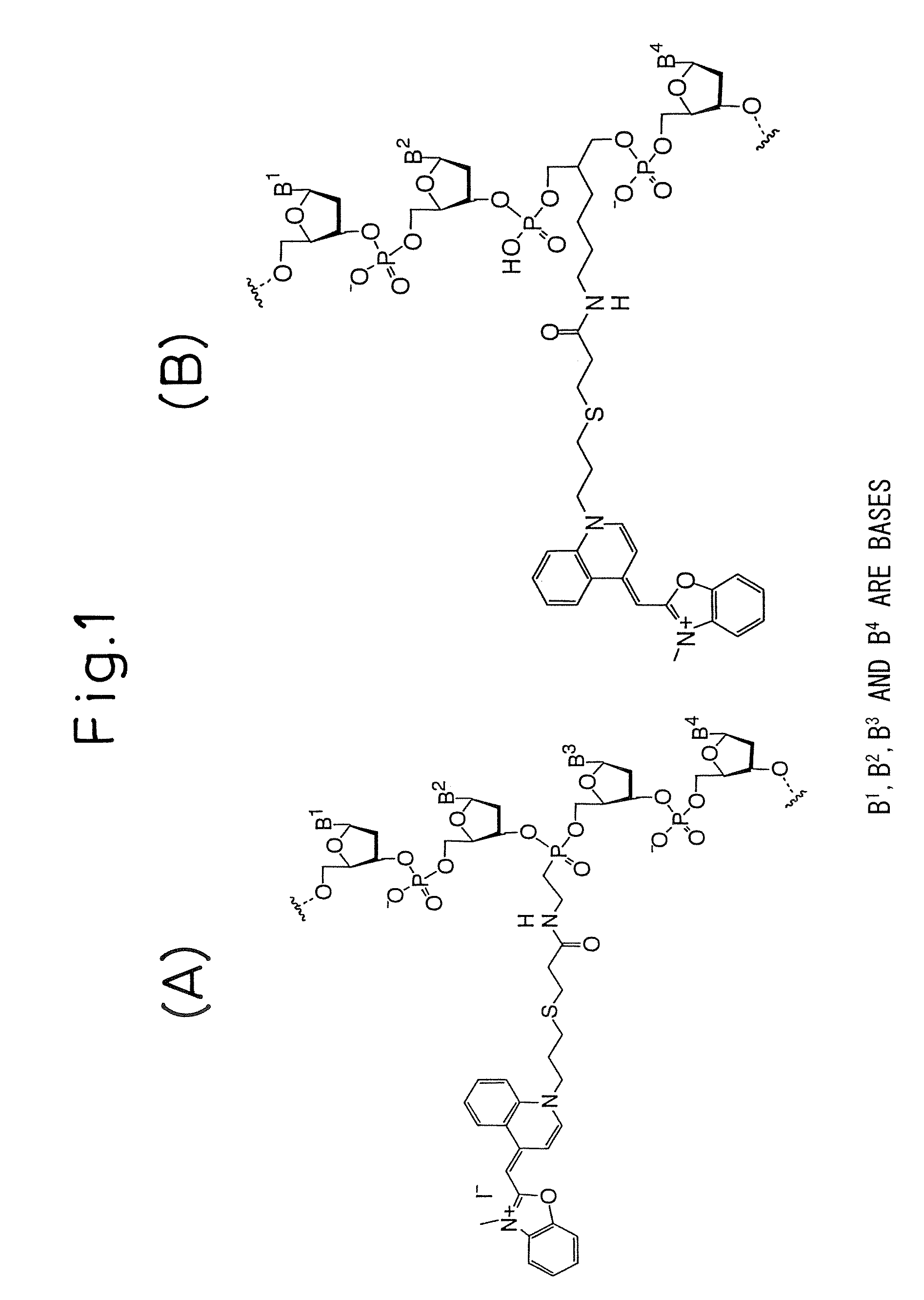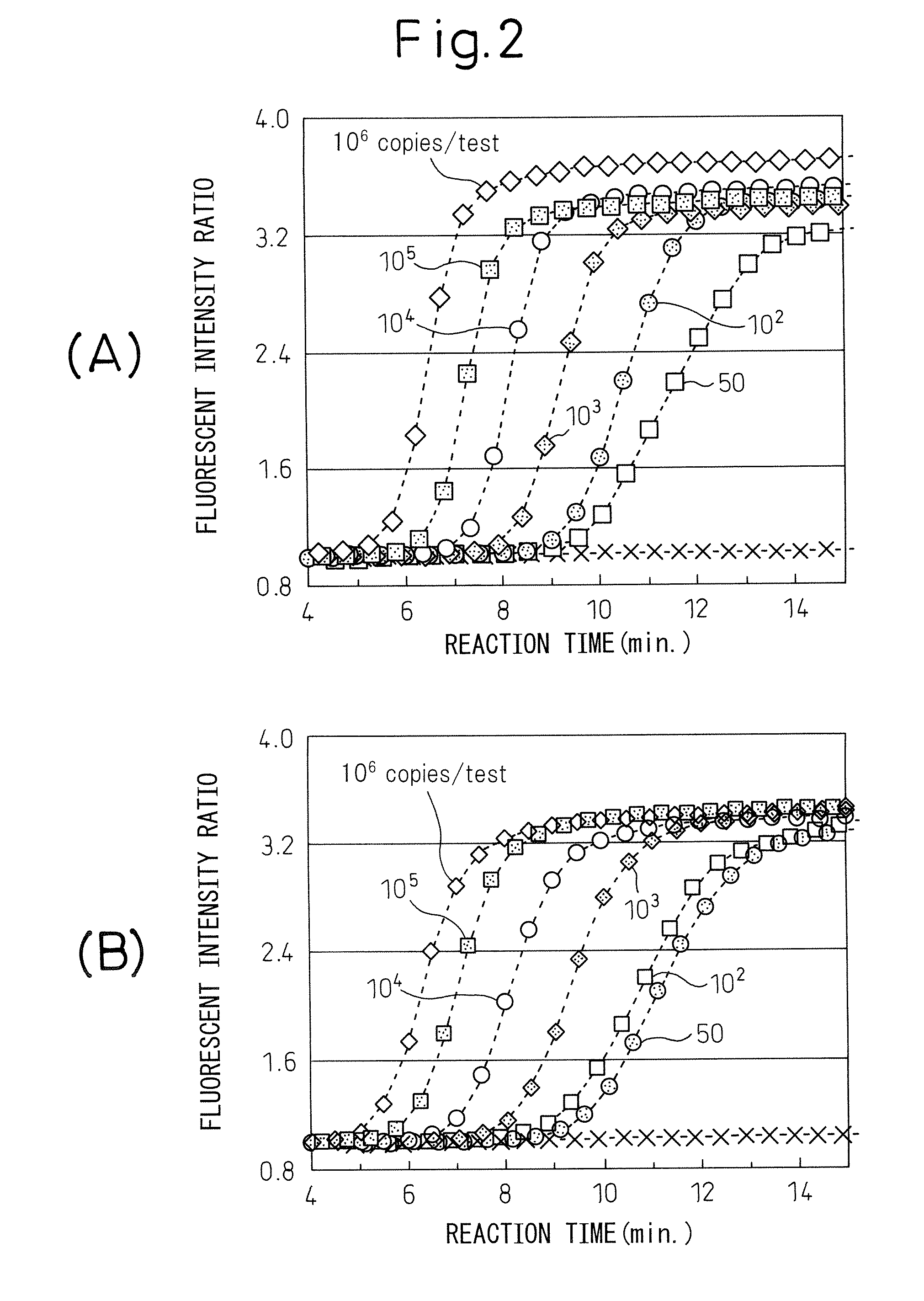METHOD FOR ASSAYING REG IV mRNA
a technology of reg iv and assaying method, applied in the field of medicine, can solve the problems of poor reproducibility, secondary contamination risk, and obstacles to the development of more achieve the effects of convenient measurement and automation, convenient, rapid, isothermal and single-stage manner, and poor reproducibility
- Summary
- Abstract
- Description
- Claims
- Application Information
AI Technical Summary
Benefits of technology
Problems solved by technology
Method used
Image
Examples
example 1
[0043] Reg IV RNA was prepared by using double-stranded DNA containing Reg IV cDNA (base numbers 1-1275, according to the base numbers assigned for National Center Biotechnology Information Accession No. NM032044) downstream from SP6 phage RNA polymerase / promoter as template for in vitro transcription, and then the double-stranded DNA was completely digested by DNaseI treatment and the RNA was purified. The RNA was quantitated by measuring the absorbance at 260 nm.
[0044] The following examples deal with this RNA as the object of measurement, but they are entirely applicable for assay of Reg IV mRNA as the object of measurement according to the invention.
example 2
[0045] Oligonucleotide probes labeled with an intercalating fluorescent dye were prepared. Amino groups were introduced at the positions of the 12th G from the 5′ end of SEQ ID NO: 43, the 10th A from the 5′ end of SEQ ID NO: 44, the 12th A from the 5′ end of SEQ ID NO: 45, the 11th C from the 5′ end of SEQ ID NO: 46, the 10th A from the 5′ end of SEQ ID NO: 47 and the 14th C from the 5′ end of SEQ ID NO: 48, using Label-ON Reagents (Clontech Laboratories, Inc.), and the 31 ends were modified with biotin. Oxazole yellow was bonded to the amino groups by the method described in Ishiguro T. et al, (1996) Nucleic Acids Res., 24, 4992-4997 (FIG. 1B). Also, an oxazole yellow-labeled nucleic acid probe was prepared having oxazole yellow bonded via a linker to the phosphate diester portion between the 9th C and 10th A from the 5′ end of the sequence listed as SEQ ID NO: 42, by the method described in Ishiguro T. et al, (1996) Nucleic Acids Res., 24, 4992-4997 (FIG. 1A).
example 3
[0046] The method of the present invention was used to detect different original numbers of copies of Reg IV RNA.
[0047] (1) The aforementioned Reg IV RNA (including base numbers 1-1275) was diluted to 50, 102, 103, 104, 105 and 106 copies / 5 μl using an RNA diluent (10 mM Tris-HCl (pH 8.0), 1 mM EDTA, 0.25 U / μl ribonuclease inhibitor, 5 mM DTT), for use as RNA samples. The RNA diluent was used as the negative standard (0 copies).
[0048] (2) After dispensing 20 μl of reaction mixture with the following composition into a 0.5 ml-volume PCR tube (GeneAmp Thin-Walled Reaction Tubes, Perkin-Elmer), 5 μl of RNA sample was added.
[0049] Reaction mixture composition (A): Concentrations are final concentrations (in 30 μl) after addition of enzyme solution.
60 mM Tris-HCl (pH 8.6)
1 mM DTT
0.25 mM dATP, dCTP, dGTP, dTTP each
3 mM ATP, CTP, UTP, GTP each
3.6 mM ITP
0.2 μM first primer (SEQ ID NO: 10): The first primer included the T7 p...
PUM
| Property | Measurement | Unit |
|---|---|---|
| fluorescent wavelength | aaaaa | aaaaa |
| fluorescent wavelength | aaaaa | aaaaa |
| temperature | aaaaa | aaaaa |
Abstract
Description
Claims
Application Information
 Login to View More
Login to View More - R&D
- Intellectual Property
- Life Sciences
- Materials
- Tech Scout
- Unparalleled Data Quality
- Higher Quality Content
- 60% Fewer Hallucinations
Browse by: Latest US Patents, China's latest patents, Technical Efficacy Thesaurus, Application Domain, Technology Topic, Popular Technical Reports.
© 2025 PatSnap. All rights reserved.Legal|Privacy policy|Modern Slavery Act Transparency Statement|Sitemap|About US| Contact US: help@patsnap.com



